倒装和省略
语法中的省略句和倒装句

语法中的省略句和倒装句在语法学中,省略句和倒装句是常见的句型。
省略句指的是在句子中省略某些成分,而倒装句则是改变了正常的词序。
本文将从基本概念、用法及实例等方面详细介绍这两种语法现象。
省略句的定义和用法省略句是指在句子中省略某些成分,但通过上下文可以明确意思。
省略的成分可以是主语、谓语、宾语、状语等。
省略句在英语中常见,可以减少重复,简化句子结构,使语言更加简洁有力。
省略句的用法多种多样,下面将分述几种常见的情况:1. 主语省略:当谓语动词是不及物动词或者使用了“there be”结构时,主语常常省略。
例如:(1) Was late for the meeting.(主语“I”被省略)(2) There is a book on the table.(主语“a book”被省略)2. 谓语省略:当句子的主语和谓语之间存在着某种逻辑关系,且谓语动词与上下文能够呼应时,可以省略谓语部分。
例如:(1) John plays tennis, and Kate does too.(谓语“plays tennis”被省略)(2) Tom likes pizza, and Jerry likes hamburger as well.(谓语“likes pizza”被省略)3. 宾语省略:当上下文已经明确了宾语的内容时,可以省略宾语。
例如:(1) Can you drive?(宾语“a car”被省略)(2) He bought a book, and I bought one too.(宾语“a book”被省略)倒装句的定义和用法倒装句是指将句子中的某些语序进行倒置的一种句型。
正常语序是主语在前,谓语在后,而倒装句则是将谓语提前或将主语放在谓语之后。
倒装句的使用可以起到强调某个部分的作用,改变句子的语气或加强语言表达的效果。
下面列举几种常见的倒装情况:1. 全部倒装:将整个谓语放在主语之前。
例如:(1) Out rushed the students.(主语“The students”在谓语“rushed”之前)(2) Never have I seen such a beautiful sunset.(主语“I”在谓语“seen”之前)2. 部分倒装:将助动词、情态动词或be动词与主语之间的顺序进行倒置。
语法中的省略句和倒装句的常见形式和结构

语法中的省略句和倒装句的常见形式和结构在语法学习中,我们常常会遇到一些特殊的句式,如省略句和倒装句。
省略句是指在句子中省去了部分成分,通过上下文可以推断出省略的内容。
而倒装句则是将句子中的某些成分颠倒位置,以突出某种语气或达到修辞的目的。
本文将详细介绍语法中的省略句和倒装句的常见形式和结构,并通过例句加以说明。
一、省略句的常见形式和结构1. 主语的省略主语的省略是最常见的省略句形式,常出现在特殊疑问句、祈使句和感叹句中。
例如:- Are you coming with us? (主语"You"被省略)- Open the door! (主语"You"被省略)- How beautiful! (主语"It"被省略)2. 谓语的省略谓语的省略常出现在上下文已经明确的情况下,避免重复使用谓语动词。
例如:- I like apples. Kate, too. (省略了第二个"I like")- He can speak English. So can I. (省略了第二个"can speak")3. 宾语的省略宾语的省略通常出现在特殊疑问句和祈使句中,或者通过上下文可以推断出省略的内容。
例如:- Did you buy milk? Yes, I did. (省略了第二个"milk")- Give me some water, please. (省略了第二个"water")4. 宾语补足语的省略宾语补足语的省略常出现在带有情态动词或者某些动词(如see, watch, hear等)的句子中。
例如:- She can play the piano. So can I. (省略了第二个"play the piano")- I heard him speak in Chinese. (省略了第二个"speak in Chinese")5. 状语的省略状语的省略常出现在上下文已经明确的情况下,避免重复使用状语词语。
高考英语语法专题复习-倒装句和省略句
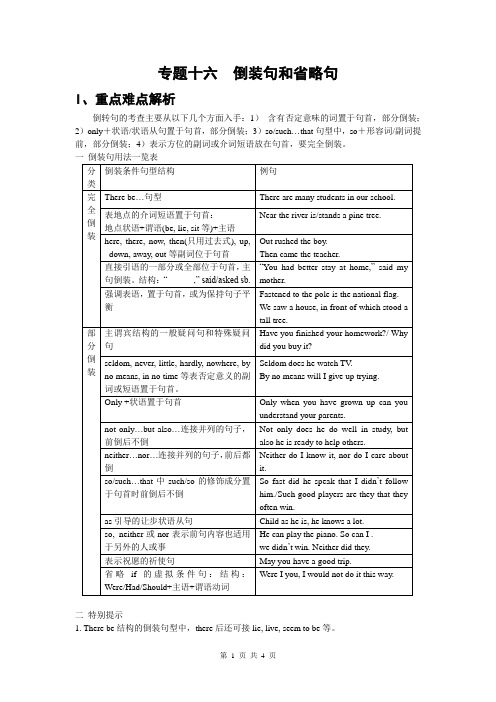
专题十六倒装句和省略句I、重点难点解析倒转句的考查主要从以下几个方面入手:1)含有否定意味的词置于句首,部分倒装;2)only+状语/状语从句置于句首,部分倒装;3)so/such…that句型中,so+形容词/副词提前,部分倒装;4)表示方位的副词或介词短语放在句首,要完全倒装。
二特别提示1. There be结构的倒装句型中,there后还可接lie, live, seem to be等。
例如:There lived an old man in the village long long ago.2. here, there, now, then(只用过去式), up, down, away, out等副词位于句首,主语为代词时不倒装。
例如:Out he rushed.3. 直接引语的一部分或全部位于句首,主句倒装。
但是主语为代词时不倒装。
“You had better stay at home,” she said.4. So位于句首不倒装的情况:主语与前句相同,表赞同, 译为“确实如此”。
例句:---Mike studies hard.---So he does. (确实是。
) 比较: (---So do I .我也是。
)5. 表示前句内容也适用于另外的人或事,前句如果列举了两种事实以上,用“So it is/waswith sb/sth.”回答。
---Tom is kind and often helps those in trouble.---So it is with his father.省略句高考命题导向:省略是一种避免重复,保持简洁的语法手段。
缺少一个或一个以上的必要语言成分,但在一定语境中能够独立存在,意义明确,并且能发挥交际功能的句子叫做省略句。
高考主要是考查省略在固定结构中的运用。
省略句用法一览表II、实战演练根据括号中的提示完成句子。
1.Not until __________________ (I; shout) at the top of my voice ________________ (he; turn) his head.2.I won the prize at last. Never in my life ___________________ (I; feel) so happy.3.Hardly _____________________ (the thief; see) the police ___________ he ran away.4.---Hurry up! There _______________________ ( the bell; go).---My goodness! Has Mrs Li come yet?---Look! Here ___________________ (he; come)5.Not only ___________________ (he; like) singing, but __________________ (he; have)a good voice.6.---David has passed the final exam smoothly.---So _________________ (he; have), and ___________________ (I, have).7.So ____________________ (he; be frightened) in the darkness that he did not dare to move an inch.8.Up _________________________ (the balloon; go) into the air.9.At the foot of the mountain _________________________ (a village; lie)10.I’v tried very hard to improve my English. But by no means _______________________ (the teacher, be satisfied) with my progress.11.If Joe’s wife doesn’t go to the party, neither ______________________.(他也不去)12.Should _________________________ (如果明天下雨), we would have to put off the sports meet.13.Child __________________ (尽管只是孩子), he shows great consideration towards the others.14.---Mike hadn’t passed the exam and was afraid of being scolded.--- ________________________. (我也一样)15.________________________________ (我们一听到铃声) than we rushed into the classroom.16.---He hasn’t finished the work yet.---Well, he _________________.(本该完成)17.The man we followed suddenly stopped and looked as if _______________ (see) whether he was going in the right direction.18.---Is your mother a teacher?---No, but she __________________.(过去是)19.---Do you know Anna’s telephone number?--- _______________ .(恐怕不知) As a matter of fact, I don’t know any Anna, either.20.---Who should be responsible for the accident?---The boss, not the workers. They just carried out the order ____________ (按被告诉的).答案:1. I shouted; did he turn 2. have I felt 3. had the thief seen; when 4. goes the bell; he comes 5. does he; he has 6. he has; so have I 7. frightened was he8.went the balloon 9. lies a village 10. is the teacher satisfied 11. will he 12. it rain tomorrow 13. as/though he is 14. So it was with me. 15. No sooner had we heard the ring 16. should/ought to have 17. to see 18. used to be 19. I’m afraid not 20. as told。
句子的倒装和省略

句子的倒装和省略句子的倒装是英文语法中常见的一种表达形式,指的是动词与主语的位置颠倒,倒装的方式有两种:完全倒装和部分倒装。
同时,省略也是英文语法中常见的一种表达手法,指的是在句子中省略掉某些成分,使得句子更加简洁明了。
在本文中,我们将探讨句子的倒装和省略,以及它们在语言表达中的应用。
一、句子的完全倒装完全倒装是指将谓语动词完全移至主语的前面,常用于以下几种情况:1. 当以here, there或者out等副词开头时:Here comes the bus.(车来了)There goes the bell.(铃声响了)Out came the sun.(太阳出来了)2. 当以否定副词或副词短语开头时:Never have I seen such a beautiful sunset.(我从未见过如此美丽的日落。
)Not only is he intelligent, but he is also hardworking.(他不仅聪明,而且勤奋。
)3. 当以介词短语或表示地点的副词短语开头时:In front of the house stood a tall tree.(房子前面矗立着一棵高大的树。
)On the hill lies a small village.(小山上坐落着一个小村庄。
)二、句子的部分倒装部分倒装是指只将助动词或情态动词移至主语之前,常用于以下几种情况:1. 当以否定词开头时:Never had I imagined that I would win the lottery.(我从未想过我会中彩票。
)Not only does he speak English fluently, but he also speaks French.(他不仅英语讲得流利,而且懂法语。
)2. 当以表示方式或原因的副词或短语开头时:In no way can I accept your offer.(我无论如何都不能接受你的建议。
英语倒装、强调和省略语法点

倒装、强调和省略倒装Inversion英语的一般语序(自然语序Natural Order)为:主语+ 谓语动词+ 宾语(或表语)+ (状语等附加成分)。
有时为了语法上或修辞上的需要而改变这种语序。
一、语法倒装1. 句首是由某些表示地点状语的副词开头,或者方位副词、介词短语放在句首时,主谓全部倒装(Full Inversion)。
比如:here, back, down, off, in, up,hence, then, thus, often, so,out, up, away, on等,通常只用于一般现在时和一般过去时,谓语动词常用be, come, go, lie, run。
主语为主语必须是名词,如果主语是人称代词则不能完全倒装。
Here is your letter. 这是你的信。
Down came the rain. 下雨了。
Hence comes the name magnet. 由此得名“磁铁”。
Into the sky went the plane. 飞机飞向天空。
Away went the girl to the school! 这个女孩到学校去了!Off goes the woman! 那个女人走了!2. 以there开头,表示“….有….”, “There+be+主语”结构;在正式文体中,当主语不明确是一个很长的名词短语时,用“there+不及物动词+主语”结构。
There are more important matters we need to discuss.我们有很多重要的事情需要讨论。
There entered a strange little man.走进来一个奇怪而身材矮小的人。
3. 主语+ live, stand, lie, sit 等动词+(介词)地点状语的结构中常采用倒装语序。
正常语序:An old temple stands at the top of the hill.倒装语序:At the top of the hill stands an old temple.山顶上有座古庙。
倒装句与省略句的区别及用法解析

倒装句与省略句的区别及用法解析倒装句和省略句是英语语法中常见的两种特殊句式。
它们的运用可以增加句子的多样性,使语言更加丰富,并帮助我们有效地表达思想。
本文将分析倒装句与省略句的区别,并介绍它们的用法。
一、倒装句倒装句是指在句子中调整主语和谓语的位置,通常有两种情况:完全倒装和部分倒装。
1. 完全倒装完全倒装句的结构为:助动词/情态动词/系动词 + 主语 + 谓语。
常见的倒装情况包括以下几种类型:1.1 肯定形式的完全倒装例如:- "Not only did he finish the project ahead of schedule, but he also exceeded our expectations." (他不仅提前完成了项目,而且超出了我们的预期。
)- "Rarely have I seen such a beautiful sunset." (我很少见到如此美丽的日落。
)1.2 否定形式的完全倒装例如:- "Never have I seen such a funny movie." (我从未见过这么有趣的电影。
)- "Little did they know what awaited them."(他们并不清楚等待他们的是什么。
)1.3 倒装的条件句例如:- "Had I known about the event, I would have attended." (要是我早知道这个事件,我就去参加了。
)2. 部分倒装部分倒装句是指将助动词/情态动词/系动词置于主语前,而谓语动词保持不变。
常见的部分倒装情况有以下几种类型:2.1 含有"only, hardly, rarely, seldom"等副词修饰状语从句的部分倒装例如:- "Only in this way can we achieve success." (只有通过这种方式,我们才能取得成功。
倒装与省略

倒装句一、全部倒装全部倒装是指将句子中的谓语动词全部置于主语之前。
此结构通常只用与一般现在时和一般过去时。
常见的结构有:1.here, there, now, then, thus等副词置于句首,谓语动词常用be, come, go, lie, run。
There goes the bell.铃响了。
2.表示运动方向的副词或地点状语置于句首,谓语是表示运动的动词。
In came the teacher.老师进来了。
注意:上述全部倒装的句型的主语必须是名词,如果主语是人称代词则不能完全倒装。
Here he comes. 他来了。
3.表地点的词语置于句首或强调地点概念时用全部倒装。
On the table were some flowers.桌子上有一些花。
二、部分倒装部分倒装是指将谓语的一部分如助动词或情态倒装至主语之前。
如果句中的谓语没有助动词或情态动词,则需添加助动词do, does或did,并将其置于主语之前。
常见的情况有:1.带有否定意义的词或短语放在句首,语序需要部分倒装。
常见的词语有:not, never, seldom, scarcely, barely, little, at no time, not only, not once, under no condition, hardly... when, no sooner... than..., not until...等。
Neither will theory do without practice,nor will practice do without theory.理论离不开实践,实践也离不开理论。
Not only did he refuse the gift, he also severely criticized the sender.他不仅拒收了礼品,还狠狠批评了送礼的人。
注意:当not until引出主从复合句时,主句倒装,从句不倒装。
省略句与倒装句型

省略句与倒装句型省略句,顾名思义,是指在表达中省略了一些词语或成分,以提高语言流畅度和简洁性。
而倒装句型则是指破坏了正常语序,将谓语动词或助动词放在主语之前的句型。
接下来,我们将分别介绍省略句和倒装句型,并为您提供一些实例。
省略句1. 主语省略在日常对话中,我们经常会省略主语,因为主语已经被上下文所指明。
例如:- A: 你吃了吗?- B: 吃了。
2. 谓语动词省略当主语和谓语动词的形式相同或者上下文中已经提到过谓语动词时,可以将谓语动词省略。
例如:- 他懂法语,我也懂。
3. 宾语省略当宾语在上下文中已经明确,或者是一个普遍性的概念时,可以将宾语省略。
例如:- A: 你想喝东西吗?- B: 想。
(省略了"喝东西")4. 介词短语省略在定语从句或者表语从句中,如果动词和介词形成一个固定的词组,可以省略介词短语。
例如:- 这是我昨天买的书。
(省略了"在书店")倒装句型1. 全部倒装在句子的全部倒装中,谓语动词或助动词位于主语之前。
例如:- Out rushed the cat.(猫冲了出来)2. 部分倒装a. 当表示地点或时间的介词短语放在句首时,需要部分倒装。
例如:- In front of the house stood a tall tree.(房子前有一棵高大的树。
)b. 在以"here"、"there" 或 "away" 开始的句子中,也需要进行部分倒装。
例如:- Here comes the bus.(车来了。
)c. 当表示否定的副词或短语位于句首时,部分倒装的结构也要使用。
例如:- Never have I seen such a beautiful sunset.(我从未见过如此美丽的日落。
)总结:通过省略句和倒装句型的运用,我们可以使句子更加简练,增强语言的表达能力和吸引力。
然而,我们在使用这些句型时,也要注意上下文的逻辑连贯性和语言的准确性。
高考英语--倒装和省略

—Look, _____. She is at the school gate.
A.there is she B.here is she
C.she there is D.there she is
答案:D
在以put/in/down/up/away或now/then/here/there等开头的句子中,主语和谓语通常完全倒装。但主语是人称代词时,主语和谓语动词语序不变,其中除then开头的句子用一般过去时外,其余一般用一般现在时表现现在进行时。
D.The hammer came down; out flew the sparks
答案:A
2.As soon as the boy pushed the door open, ______.
A.the boy rushed out B.out the boy rushed
倒装和省略
一、倒装
英语句子的自然语序是主语在前,谓语动词在后。把谓语动词放在句子之前,就叫倒装结构。如果全部谓语动词放在主语之前,叫全部倒装;如果只把助动词或情态动词放在主语之前就叫部分倒装。
(一)全部倒装
B.So he has; so have you
C.So has he; so have you
D.So has he; so you have
答案:B
例6.—I don’t think I can walk any further.
—______. Let’s stop here for a rest. (1985 NMET)
例1.Look, ________ (1996 NMET)
A.here the bus come B.the bus comes here
分析语言中的倒装和省略现象

分析语言中的倒装和省略现象倒装和省略是语言中常见的现象,它们在语法结构和表达方式上有一定的变化,能够增添语言表达的灵活性和多样性。
本文将对语言中的倒装和省略现象进行分析。
一、倒装现象倒装是指将主语和谓语的位置颠倒的语法现象。
在语言中,主要存在两种倒装形式:完全倒装和部分倒装。
1. 完全倒装完全倒装是指将整个谓语动词置于主语之前,形成倒装的结构。
一般情况下,完全倒装出现在以下几种情况中:(1)以副词或介词开头的句子:In front of the house stood a tall tree.(在房子前面矗立着一棵高大的树。
)(2)以表示地点的状语短语开头的句子:On the top of the mountain lies a beautiful temple.(在山顶上有一座美丽的寺庙。
)(3)以表示方式的状语短语开头的句子:In silence did he leave the room.(他默默地离开了房间。
)2. 部分倒装部分倒装是指将助动词、情态动词、系动词或助动词+动词原形置于主语之前,形成倒装的结构。
常见的情况有:(1)用于强调句子部分:Only by working hard can we achieve success.(只有通过努力工作,我们才能取得成功。
)(2)用于条件句:Should it rain, we will cancel the outdoor activities.(如果下雨的话,我们将取消户外活动。
)(3)用于虚拟语气语句:Were I taller, I would be able to reach the top shelf.(如果我个子高一些,我就能够够到顶层货架了。
)二、省略现象省略是指在语言表达中省略一个或多个词语的现象,常出现在口语和非正式写作中。
省略的主要目的是为了简化句子结构、减少重复以及提高语言流畅度。
1. 主语省略在交流中,常常会进行简化交际,即省略主语,直接使用谓语动词或谓语动词的变化形式。
句子的倒装与省略

句子的倒装与省略句子的倒装与省略是英语语法中的重要部分,它们在句子结构和表达方式上带来了独特的变化。
本文将从倒装句和省略句两个方面进行探讨,并介绍它们的用法和注意事项。
一、倒装句倒装句是指将正常语序的主语和谓语动词颠倒位置,形成不同于正常语序的句子。
常见的倒装结构有两种情况:完全倒装和部分倒装。
1. 完全倒装完全倒装是将谓语动词放在主语之前,用于以下情况:a) 在以副词或短语开头的句子中,如"Never have I seen such a beautiful sunset."(我从未见过如此美丽的日落。
)b) 在以地点状语或时间状语开头的句子中,如"Down the street camea group of children."(一群孩子沿着街道走来。
)2. 部分倒装部分倒装是将助动词或情态动词与主语的位置互换,用于以下情况:a) 在含有否定副词或词组的句子中,如"Never have I been so disappointed."(我从未如此失望。
)b) 在以only、hardly、not until等副词开头的句子中,如"Only by working hard can you achieve success."(只有通过努力工作,你才能获得成功。
)二、省略句省略句是指在表达中省略掉某些成分,但仍能保持句子的完整和意义的语法结构。
常见的省略句有以下情况:1. 主语省略当主语在句子中已经明确或可通过上下文推断时,可以省略主语。
如"I like coffee, and (I) also enjoy tea."(我喜欢咖啡,而且我也喜欢茶。
)2. 谓语动词省略当句子已经有了一个谓语动词,而后面的句子也需要表达相同的动作时,可以省略后面的谓语动词。
如"I can swim, but he can't (swim)."(我会游泳,但他不会。
特殊句式之倒装句以及省略句讲义
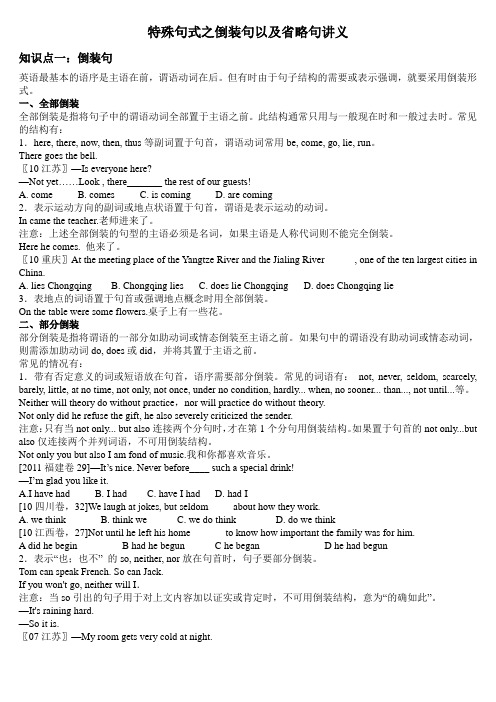
特殊句式之倒装句以及省略句讲义知识点一:倒装句英语最基本的语序是主语在前,谓语动词在后。
但有时由于句子结构的需要或表示强调,就要采用倒装形式。
一、全部倒装全部倒装是指将句子中的谓语动词全部置于主语之前。
此结构通常只用与一般现在时和一般过去时。
常见的结构有:1.here, there, now, then, thus等副词置于句首,谓语动词常用be, come, go, lie, run。
There goes the bell.〖10江苏〗—Is everyone here?—Not ye t……Look , there_______ the rest of our guests!A. comeB. comesC. is comingD. are coming2.表示运动方向的副词或地点状语置于句首,谓语是表示运动的动词。
In came the teacher.老师进来了。
注意:上述全部倒装的句型的主语必须是名词,如果主语是人称代词则不能完全倒装。
Here he comes. 他来了。
〖10重庆〗At the meeting place of the Yangtze River and the Jialing River______, one of the ten largest cities in China.A. lies ChongqingB. Chongqing liesC. does lie ChongqingD. does Chongqing lie3.表地点的词语置于句首或强调地点概念时用全部倒装。
On the table were some flowers.桌子上有一些花。
二、部分倒装部分倒装是指将谓语的一部分如助动词或情态倒装至主语之前。
如果句中的谓语没有助动词或情态动词,则需添加助动词do, does或did,并将其置于主语之前。
常见的情况有:1.带有否定意义的词或短语放在句首,语序需要部分倒装。
高考英语总复习-倒装句与省略句用法

倒装句与省略句用法第一、倒装句用法英语的基本句型是主语 + 谓语。
如果将主语与谓语调换, 称倒装句。
倒装句分全倒装句和半倒装句。
一、全倒装: 主语与谓语交换位置不需任何助动词, 叫全倒装。
全倒装有以下三种情况:1、当here, there, out, in, up, down等副词放在句首时, 句子需全倒装:There goes the bell! 铃响了!There lived an old man in the village.村里有一位老汉。
Here comes the bus.汽车来了。
注意:①在这种情况下倒装仅限于不及物动词或be动词, 像go, come, rush,march等。
②主语如果是代词时不需倒装如Away he went. 他走远了。
2、方位状语在句首, 如:In front of the house stopped a police car.房前停一辆警车。
Nearby were two canoes in which they had come to the island.附近有两只小船,他们乘着来到这个小岛。
Under the tree sat a boy.树下坐着一个小男孩。
3 、直接引语在句首, 这种情况可倒装也可不倒装“What does it mean?” asked the boy或the boy asked.二、半倒装: 主语与谓语的助动词交换位置称半倒装, 有以下数种情况:1、否定意义的词在句首, 句子半倒装, 例如: little, never, not, no, hardly, rarely, seldom 等。
Never shall I forget you.我绝不会忘记你。
At no time was the man aware of what was happening. 这人绝不知道发生了什么事情。
Little did I understand what he said to me at that time. 当时我不知道他对我说什么。
倒装省略插入语语法讲解
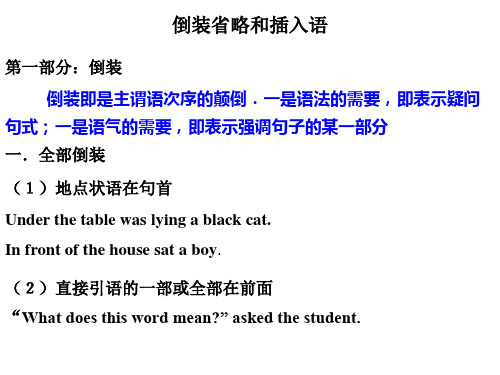
第一部分:倒装 倒装即是主谓语次序的颠倒.一是语法的需要,即表示疑问 句式;一是语气的需要,即表示强调句子的某一部分 一.全部倒装
(1)地点状语在句首
Under the table was lying a black cat. In front of the house sat a boy. (2)直接引语的一部或全部在前面 “What does this word mean?” asked the student.
Please write to me as often as ( it is ) possible. He made up his mind to finish the job whether ( it was ) difficult or not. They do not use more water than ( it is ) necessary. I’m taller than he ( is tall). Anyone, no matter who ( he is ), may point out our shortcomings. (3)在宾语从句中如果意义不会造成混乱就可以省略 that I think (that ) it will clear up this afternoon. I believe ( that ) he will pass the national college entrance examination. 下面句子中的 that 就不能省略: He said angrily that he shouldn’t be blame to the matter. I see that he is sure to come to help me.
省略与倒装句解析
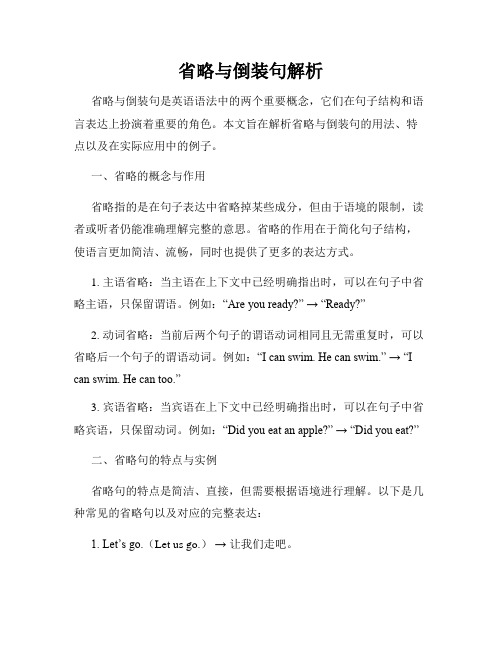
省略与倒装句解析省略与倒装句是英语语法中的两个重要概念,它们在句子结构和语言表达上扮演着重要的角色。
本文旨在解析省略与倒装句的用法、特点以及在实际应用中的例子。
一、省略的概念与作用省略指的是在句子表达中省略掉某些成分,但由于语境的限制,读者或听者仍能准确理解完整的意思。
省略的作用在于简化句子结构,使语言更加简洁、流畅,同时也提供了更多的表达方式。
1. 主语省略:当主语在上下文中已经明确指出时,可以在句子中省略主语,只保留谓语。
例如:“Are you ready?” → “Ready?”2. 动词省略:当前后两个句子的谓语动词相同且无需重复时,可以省略后一个句子的谓语动词。
例如:“I can swim. He can swim.” → “I can swim. He can too.”3. 宾语省略:当宾语在上下文中已经明确指出时,可以在句子中省略宾语,只保留动词。
例如:“Did you eat an apple?” → “Did you eat?”二、省略句的特点与实例省略句的特点是简洁、直接,但需要根据语境进行理解。
以下是几种常见的省略句以及对应的完整表达:1. Let’s go.(Let us go.)→ 让我们走吧。
2. Can I have a coffee?(Can I have a cup of coffee?)→ 我可以来杯咖啡吗?3. I love reading, and my sister does too.(...my sister loves reading too.)→ 我喜欢阅读,我姐姐也一样。
三、倒装句的概念与用法倒装句是指把句子中的主语和谓语动词的位置调换,形成倒装结构。
倒装句用于强调、修辞或特殊疑问句等情况,具有一定的语气和语法效果。
1. 完全倒装:整个主谓语序调换。
例如:“He is coming.” → “Is he coming?”2. 部分倒装:部分倒装是指将助动词、情态动词或系动词与主语进行调换。
高中英语语法特殊句式(倒装、省略、强调)

3.在对话或并列句中,如果主语(zhǔyǔ)、谓语不同,而宾语相同, 则常省去相同的宾语部分。 Tom enjoys dancing, but Peter hates (dancing).
精品资料
4.省略作宾语的不定式短语,只保留to,但如果该宾语是动词 be或完成时态,则须在之后加上be或have: —Are you going there? —Yes, I’d like to (go there). 注意(zhù yì):在下列词后常省略不定式但要保留to: want, wish, like, hate, hope, intend, plan, love, refuse, expect,但当 want 和like用于从句中时,to常常省略。
My office was on the tenth floor, and his (office was) on the twelfth (floor). 并列句的省略有时还可出现在前面(qián mian)的分句 中,这时被省略的词语便出现在下文。
精品资料
5.only + 状语(zhuàngyǔ)(副词、介词短语、状语(zhuàngyǔ)从句)放在句首时 。(部分倒装) 1)Only then did I realize the value of reading aloud every morning. 2)Only by means of talking can we avoid misunderstanding each other.
精品资料
2.方位词in, out, there, here, inside, outside, up, down, away, off, downstairs, upstairs等以及now, then置于句首时,谓语动词常用 be, come, go, lie, run等,并且句子的主语(zhǔyǔ)是名词。为以示 强调或为了使情景更生动, 要全部倒装。(全部倒装) 1) Away flew the bird which I bought yesterday. 2) Now comes your turn to sweep the floor. 注意: 主语(zhǔyǔ)是人称代词时,仍用自然语序。 Away they went. (=They went away.)
省略和倒装
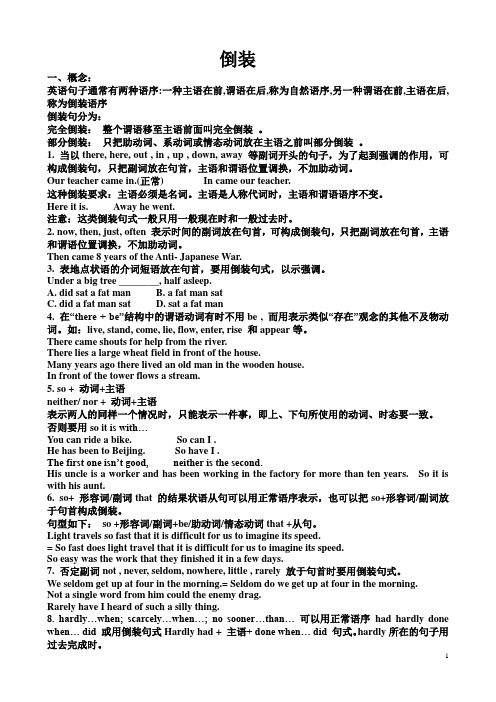
倒装一、概念:英语句子通常有两种语序:一种主语在前,谓语在后,称为自然语序,另一种谓语在前,主语在后,称为倒装语序倒装句分为:完全倒装:整个谓语移至主语前面叫完全倒装。
部分倒装:只把助动词、系动词或情态动词放在主语之前叫部分倒装。
1. 当以there, here, out , in , up , down, away 等副词开头的句子,为了起到强调的作用,可构成倒装句,只把副词放在句首,主语和谓语位置调换,不加助动词。
Our teacher came in.(正常) In came our teacher.这种倒装要求:主语必须是名词。
主语是人称代词时,主语和谓语语序不变。
Here it is. Away he went.注意:这类倒装句式一般只用一般现在时和一般过去时。
2. now, then, just, often 表示时间的副词放在句首,可构成倒装句,只把副词放在句首,主语和谓语位置调换,不加助动词。
Then came 8 years of the Anti- Japanese War.3. 表地点状语的介词短语放在句首,要用倒装句式,以示强调。
Under a big tree ________, half asleep.A. did sat a fat manB. a fat man satC. did a fat man satD. sat a fat man4. 在“there + be”结构中的谓语动词有时不用be , 而用表示类似“存在”观念的其他不及物动词。
如:live, stand, come, lie, flow, enter, rise 和appear等。
There came shouts for help from the river.There lies a large wheat field in front of the house.Many years ago there lived an old man in the wooden house.In front of the tower flows a stream.5. so + 动词+主语neither/ nor + 动词+主语表示两人的同样一个情况时,只能表示一件事,即上、下句所使用的动词、时态要一致。
倒装句与省略句讲解

倒装句与省略句倒装句和省略句是英语中常用的两种特殊句式。
倒装句是指由于修辞的需要,谓语动词发生前移的语句。
省略句,省略句子中的某个或某些成分。
有了倒装句和省略句,英语句子家族更加多姿多彩,语言表达也更加丰富了。
一、倒装句英语句子的语序有时由于修辞的需要,把谓语或部分谓语提到主语之前,这样的句子称为倒装句。
倒装句分为完全倒装(谓语全部置于主语之前)和部分倒装(部分谓语放在主语之前)两种。
1 完全倒装句子的主语较长时(多数情况下又没有宾语),因为要避免头重脚轻的感觉,通常把表语或状语放在句子的前面。
例如:Before the thief stood John who was a detective and had arrested him twice.这个小偷的面前站着曾逮过他两次的探长约翰。
In the small box was the ring that he had given her twenty years before.那个小盒里面是那枚他二十年前送给她的戒指。
So shocked was she at the news that he had died the day before.获悉他昨天去世的消息,令她十分震惊。
2 部分倒装(1)so, neither, nor位于句首,表示与前面谓语所述情况相同。
例如:I am a doctor.我是医生。
So am I.我也是(医生)。
He will go skating.他要去滑冰。
So will she.她也要去(滑冰)。
I didn't finish my homework.我作业没写完。
Neither did I.我也没写完。
I haven't been to the Summer Palace.我没有去过颐和园。
Neither have I.我也没有去过(颐和园)。
The two-year-old child can not eat a meal herself; nor can she dress (herself).这个两岁的孩子还不会自己吃饭,她也不会自己穿衣服。
- 1、下载文档前请自行甄别文档内容的完整性,平台不提供额外的编辑、内容补充、找答案等附加服务。
- 2、"仅部分预览"的文档,不可在线预览部分如存在完整性等问题,可反馈申请退款(可完整预览的文档不适用该条件!)。
- 3、如文档侵犯您的权益,请联系客服反馈,我们会尽快为您处理(人工客服工作时间:9:00-18:30)。
一般过去时外,其余一般用一般现在时表现现在进行时。
Ex 1._____and _______.
A.Down came the hammer; out flew the sparks
B.Down came the hammer; out the sparks flew
C.Down the hammer came; out the sparks flew
1.倒装具有客观性。即倒装是因为约定俗成的。 例如:当人们见面时,一般都说“How are you?”而不说“You are how?”。这种倒装是
不以人的主观意志而改变的。
2.倒装具有主观性。即倒装可因说话者表达的需要而形成。例如:人们可以说“The students didn’t begin the experiment until their teacher had explained how.”也可说“Not until their teacher had explained how did the students begin the experiment.”但后者明显突出了学 生晚做实验这一信息。
D.Were such my brothers
答案:B
such 通常用于:
such+be+n.句型中作代词,指代其后作主语的名词,be 动词的人称和数须与主语
一致。
Ex.Such _______ Nick and such ______ his words.
A.was; was
B.were; were
B.So did he
C.So he did, too
D.So did he, too
答案:A
例7.________, too naughty but clever boys.
A.My brothers were such
B.Such were my brothers
C.Such my brothers were
但直接引语后若用代词注明说话者,主语和谓语一般要部分倒装,即“…”sb. says/said。
如:“Who is paying?”shouted the fat woman at the corner.“You are”, I answered.“谁付钱?”
拐角处的胖女人大声嚷道。“你付。”我答道。
例(2)上文表示否定意义,根据下文“让我们停下来歇会儿”的语境推测,应答者
是想表达“我也走不动了”的意思。A 项中,助动词 am 同上文中的 can walk 不一致;I don’t
think so 表“我认为你走不动了”之意,似答非所问;I think so 则表示“我想你走得动”,与
紧随其后的“让我们停下来歇会儿”之意相矛盾。因此,只有 B 项符合题意。
D.The hammer came down; out flew the sparks
答案:A
2.As soon as the boy pushed the door open, ______.
A.the boy rushed out
B.out the boy rushed
C.out he rushed
(二)部分倒装
例1.I finally got the job I dreamed about. Never in all my life _____ so happy. (2000北京春
季,22)
A.did I feel
B.I felt
C.I had felt
D.had I felt
答案:D
含有否定意义的副词或介词短语置于句首时,句子的主谓结构要部分倒装。若句子
若考生选 A,则认为 there lies a big farm 也是一个倒装句型;若考生选 C,则认为 a big farm lies there 是一个规范的主谓结构;若考生选 D,则认为 does a big farm lie 是一 个部分倒装句型。但今后若碰到方位词在句首,且动词是不及物动词,而主语又是名词 时,脑子里应有全部倒装的概念。 Ex.On one side of Tian An Men Square ______. A. the Great Hall of the People stands B.does the Great Hall of the People stand C.stands the Great Hall of the People D.there the Great Hall of the People stands 答案:C 例5.—David has made great progress recently. —______, and ______. (1997上海,27) A.So he has; so you have B.So he has; so have you C.So has he; so have you D.So has he; so you have 答案:B 例6.—I don’t think I can walk any further.
的谓语是由两部分或两部分以上组成的,只需将助动词或第一助动词提到主语前面即
可;若句子的谓语是由一部分组成的,此时则需要借助于助动词 do 倒装,do 体现谓语
动词的时态和人称;若句子谓语动词是单个 be 的相关形式,则直接将该 be 置于主语之
前即可。(以下部分倒装方法皆同)
此类副词和介词短语主要有:not, never, seldom, hardly, rarely, little, by no means, in
此句中的主语是 a girl,其前的 stood 是谓语。主语和谓语的位置完全颠倒了。
Little did he care about his own safety, though he was in great danger himself. 尽管他本人身处险境,却不顾及自己的安全。
此句中的主语是 he, 谓语是 did 和 care, 主语和谓语被部分倒装了。 要掌握倒装结构的用法,必须弄清倒装的如下特征:
C.was; were
D.were; was
答案:C
例8.“We can’t go out in this weather,”said Bob, ______ out of the window.
A.looking
B.to look
C.looked
D.having looked
答案:A
直接引语后若用名词注明说话者,主语和谓语一般要全部倒装,即“…”says/said sb;
—______. Let’s stop here for a rest. (1985 NMET)
A.Neither am I
B.Neither can I
C.I don’t think so
D.I think so
答案:B
在表示某人某事或某种情况与前面提到的相同这一概念时,英语中通常用
“so/neither/nor+be/have 助动词/情态动词+主语”句型。其意思是:乙(与甲一样)也是
Ex.1.She is not fond of cooking, ________.
A.so am I
B.neither I do
C.neither do I
D.neither am I
答案:D
2.—John won the first prize in the contest.
—_______.
A.So he did
a picnic in the forest.(2004上海,41)
A.Not only they brought
为了表示强调,英语中有时会将表方位或地点的状语提到句首而形成“方位+不及 物动词(一般现在时/一般过去时)+名词”完全倒装句型。
east of which 是一个表方位的短语,从句中的主语是 a big farm。若选 A,there 就多 余了;若选 C 和 D,不符合习惯表达。只有 B 项符合习惯表达。
为了避免头重脚轻,英语中常常将作表语用的不定式/形容词/分词及后面的部分移 至句首,使之形成“表语部分+适当形式的 be+主语”的完全倒装。
例句中主语为 Professor White,其后还跟了个非限定性定语从句,根据定语从句要 紧跟先行词的这一用法,若按照规定句型表述,主语和谓语之间就因隔太远而显得不够 紧凑。 Ex.______, in which they had come to the island. A.Two small boats were nearby B.Nearby were two small boats C.Nearby two small boats were there D.There nearby were two small boats 答案:B 例4.Before dark, we arrived at a small town, east of which ______. A.there lies a big farm B.lies a big farm C.a big farm lies there D.does a big farm lie 答案:B
如此。但当答句中主语未变,且仅表重复或附和时,英语中通常用“so sb. do /be/助动词/
情态动词”句型。其意思是:甲的确如此。
例(1)上文是在夸奖第三者,且第一空中主语与上文的主语没变,只能用表附和
的语气应答,即 so he has; 第二空中主语变了,根据对话意义连贯性原则,应是乙方对
甲方的夸奖,答语应为 so have you 因此,只有 B 项符合要求。
复习策略
一、倒装
英语句子的自然语序是主语在前,谓语动词在后。把谓语动词放在句子之前,就叫
倒装结构。如果全部谓语动词放在主语之前,叫全部倒装;如果只把助动词或情态动词
